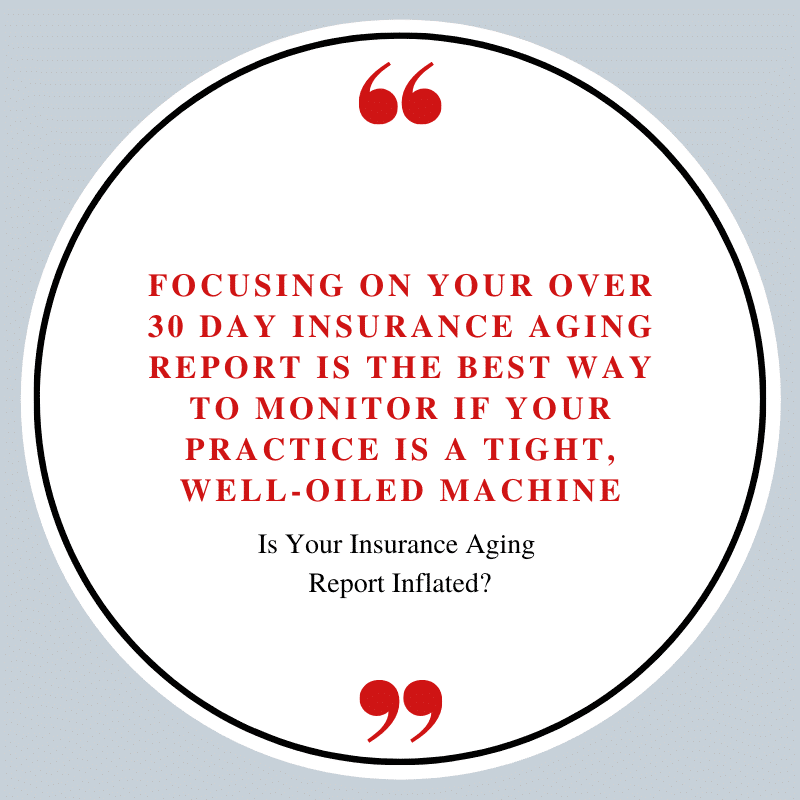Is Your Insurance Aging Report Inflated?


It happens often that doctors and OMs believe their aging report is an accurate estimate of receivables owed to the practice. Because the report says a certain amount is outstanding, the belief is that this is exactly what they should be able to put in their pockets. Unfortunately this is not true. Understanding why is crucial to predicting your actual insurance payments based on the numbers in your insurance aging report.
Focusing on your over 30 day insurance aging report is the best way to monitor if your practice is a tight, well-oiled machine.. (Take a look at our blog “What Your Insurance Aging Report is telling you!” for a detailed explanation.)
So here’s an example I want to share with you. Your total insurance aging report shows $200,000 outstanding – every claim created and sent and outstanding. Wow, that’s a lot of money! The amount of this aging report over 30 days is $50,000. This means that your insurance aging report over 30 days makes up 25% of the report. Ideally you want this % under 10%, but that’s another discussion. The question here is, if I’m looking at my over 30 day report, should I expect $50,000 to be coming in from these old claims? The common misconception is yes, but the reality is NO! So, why is this number inflated?
Here are 3 reasons your insurance aging report could be inflated:
1. Claims Paid But Not Posted
-
-
- Checks and balances are not in place at every office. Deposit reports aren’t run every day, different staff members are responsible for a multitude of responsibilities, roles switch and change, etc. This means that things fall through the cracks!
- If your doctor, or whomever is in charge of depositing checks, doesn’t make sure claim payments are posted before taking the deposit to the bank, those claims will linger on the report.
- If your office receives EFTs/VCC from insurance companies, but the RAs (electronic EOBs) are not retrieved and posted, then these claims still lurk on the aging report, YET the doctor’s bank account has already been credited.
-
2. Claims Denied But Not Cleared
-
-
-
- Claims deny for multiple reasons and sometimes they are accurate denials. Frequency, missing tooth clause, waiting period, and max reached are typical accurate denials that show up on insurance aging reports all the time. These claims carry a dollar amount, so if they are not cleared off your aging report, they only inflate the report showing more money should come in from insurance than what is realistic.
-
-
3. Insurance Aging Report Dollar Amount is Often UCR
-
- Write-offs- Since the aging report dollar amount is the UCR dollar amount, you have to take into account write-offs from any PPOs you participate with.
- Example: A claim for a $1,200 crown. The in-network fee is $800…
- Your report is already inflated $400 ($1,200 – $800 = $400)
- Example: A claim for a $1,200 crown. The in-network fee is $800…
- Coverage Percents- Many procedures only pay at a percentage of the fee associated with them.
- Example: The same claim for a $1,200 crown. The in-network fee is $800 and insurance is only going to pick up 50% of that.
- Barring any deductible, we can only expect $400 payment from insurance even though the report shows a $1,200 claim outstanding.
- Example: The same claim for a $1,200 crown. The in-network fee is $800 and insurance is only going to pick up 50% of that.
- Write-offs- Since the aging report dollar amount is the UCR dollar amount, you have to take into account write-offs from any PPOs you participate with.
A great way to determine what you should bring into your practice from insurance is to run your current aging report (0-30) number. Divide your monthly insurance collections by this number, and you can find out a predictable dollar amount of what you should collect from insurance monthly based off the current (0-30) dollar amount of your insurance aging report.
Here’s an example for clarity:
Your current insurance aging: (0-30 days )= $100,000
Insurance collections total: $40,000/month
This means you usually bring in 40% in insurance ($40,000/$100,000= 40%) of whatever dollar amount is on your current insurance aging report.
Understand your insurance aging report. Know who you are in network with and what your average write-offs are on a month-to-month basis. Be able to confidently predict your numbers and sleep soundly, knowing dental insurance is NOT your Achilles heel.
-Josh Smith
Dental ClaimSupport
Related Posts
Dental revenue resources from Dental Claim Support
.png)